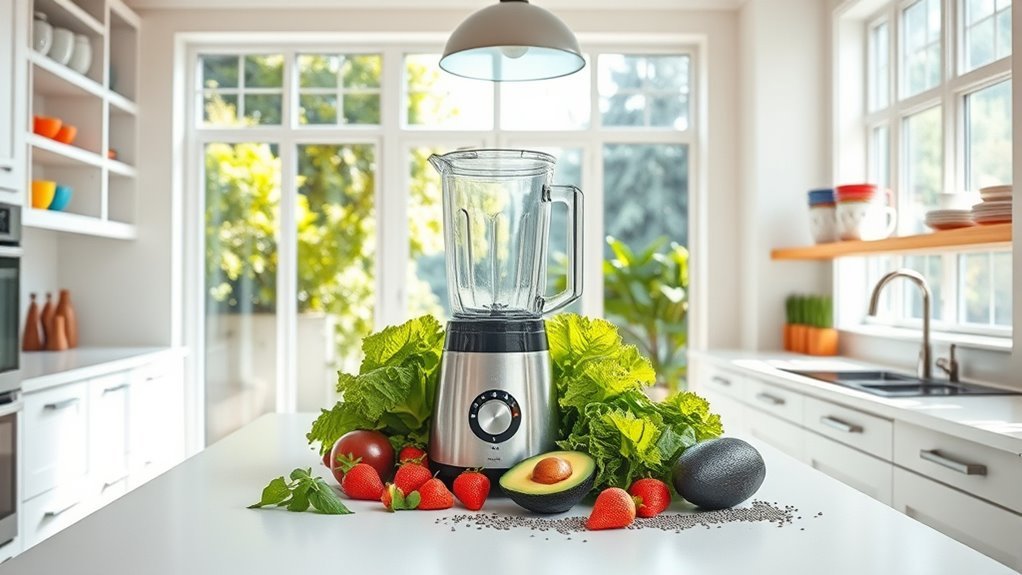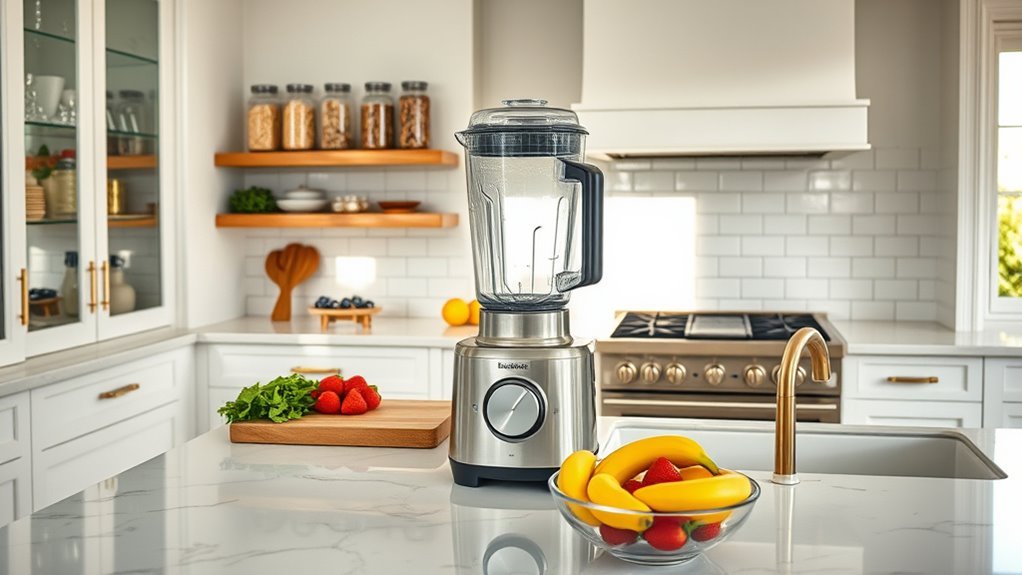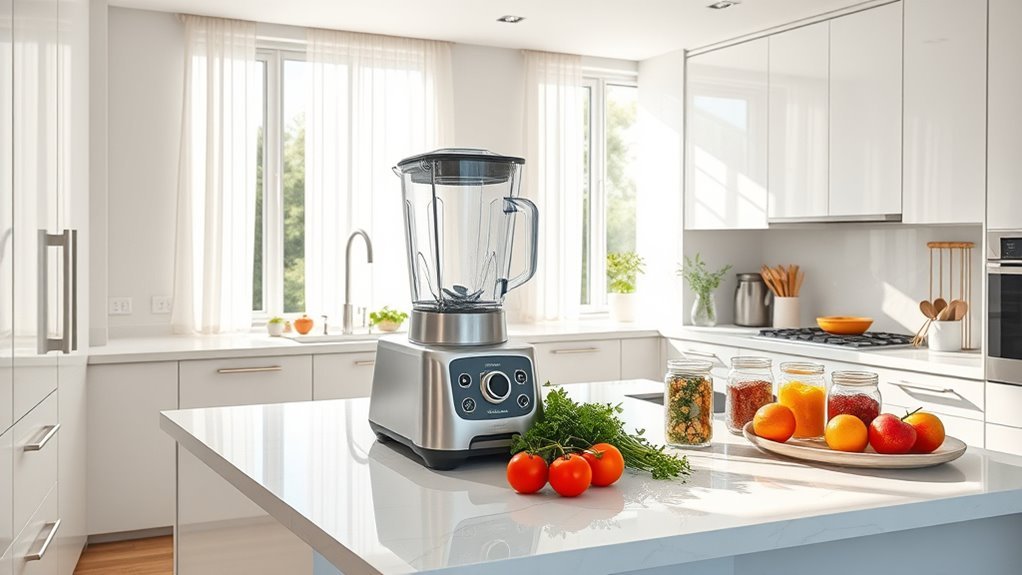We’ve cracked the code on high-speed blender noise with five battle-tested techniques. Start with thick rubber mats under your blender to absorb vibrations, then add self-adhesive dampening pads to the feet. Begin blending at low speeds, gradually increasing power while using strategic pulse bursts. Consider a compact soundproof enclosure lined with acoustic foam. For tight spaces, slim dampening mats work wonders. There’s more to discover about maximizing your blender’s stealth mode.
The Science Behind High-Speed Blender Noise

While most of us appreciate a powerful blender, we can’t ignore the roaring beast it becomes at full throttle.
Here’s the cold truth: high speed processing creates multiple sources of noise. Those stainless steel blades spinning at up to 35,000 rpm generate intense friction and vibrations that ricochet through the entire unit. Hard surfaces like countertops amplify these sound waves, creating a perfect storm of acoustic chaos.
The blender’s design itself plays a vital role in noise production. Container shape, blade configuration, and motor housing all contribute to the symphony of sound.
Metal components and rigid materials enhance vibrations, turning your morning smoothie session into a mini rock concert. That’s precisely why noise reduction techniques, from sound enclosure systems to dampening mats, have become essential weapons in our quest for quieter blending. Additionally, the powerful motors in high-performance blenders contribute to the overall blending efficiency that many users value.
Sound-Dampening Materials and Placement
When it comes to taming your blender’s ruckus, sound-dampening materials are your secret weapon.
Let’s start with the basics: thick rubber or silicone sound dampening mats under your blender will instantly reduce vibration transfer.
We’ll add self-adhesive sound dampening pads beneath the feet for extra isolation from your countertop.
For serious noise reduction, we’ve got two premium options.
Create a DIY soundproof box using acoustic foam panels and high-density insulation foam – it’s surprisingly effective.
Or invest in a ready-made enclosure lined with professional noise-blocking materials and mass-loaded vinyl sheets.
Both solutions dramatically improve soundproofing efficiency. Additionally, consider the motor power of high-performance blenders, as higher wattage can contribute to increased noise levels during operation.
Here’s the bottom line: proper placement of these materials isn’t just about noise reduction – it’s about maintaining your sanity during high-speed blending sessions.
Strategic Timing and Speed Control

Beyond sound-dampening hardware, masterful control of your blender’s speed and timing makes the difference between a jet engine and a gentle hum.
We’ll show you how to achieve quiet blending through strategic timing and smart speed management.
Start at low speed – always. It’s non-negotiable. Gradually ramp up to high speed settings while letting the motor ease into the workload.
We’ve found the pulse function is your secret weapon for noise control – use it in short bursts rather than running continuously. Think of it as percussion rather than a sustained note.
By timing these bursts strategically and controlling the intervals, you’ll maintain lower operational sound while still getting that perfectly smooth blend.
It’s not just about noise reduction – it’s about working smarter, not louder.
Equipment Modifications for Quieter Operation
Although your blender’s factory settings might be set to “airplane takeoff” volume, we’ve got the gear modifications to bring that decibel level back down to earth.
Start with a heavy-duty sound dampening mat under your blender – thick rubber or silicone works wonders to absorb vibrations and reduce noise levels.
Let’s get serious about quiet operation. Install self-adhesive pads under those feet to isolate the racket from your countertop.
Want to go full stealth? Build a custom soundproof box with acoustic foam panels, or invest in a ready-made sound enclosure. Think of it as your blender’s personal isolation chamber.
Just remember: stability is key. A properly mounted heavy-duty mat stops those bone-rattling vibrations before they start. Your neighbors will thank you.
Space-Saving Soundproofing Solutions

Since space comes at a premium in most kitchens, we’re tackling noise control solutions that won’t eat up your precious counter real estate.
Start with a slim sound dampening mat under your blender – it’s practically invisible but packs serious noise reduction power. Add self-adhesive pads beneath the feet for extra isolation during high-speed blending.
For maximum soundproofing without the bulk, consider a collapsible soundproof box lined with acoustic foam. These fold flat when not in use but deploy instantly when you need serious noise-blocking materials.
Not feeling crafty? Compact ready-made solutions like Whisper Blender enclosures offer professional-grade soundproofing without permanent installation.
Remember: effective soundproofing solutions don’t require massive space – just smart material choices and strategic placement.
Frequently Asked Questions
How Do I Make My Blending Quieter?
We’ll reduce blender noise by using vibration dampening methods like rubber mats, installing soundproofing pads under feet, and considering noise reduction accessories or a dedicated sound enclosure for quieter operation.
What Speed to Blend Smoothies?
While 78% of smoothie success relies on speed control, we’ll achieve perfect consistency by starting low (speed 3-4) for 10 seconds, then ramping up to maximum speed for 30-45 seconds with frozen fruits.
What Settings to Use on Blender for Smoothies?
We’ll start on low speed with soft smoothie ingredients, then increase to high for frozen fruits. Use Pulse for tough items, and blend until we reach desired consistency.
Why Is My Blender so Noisy?
Your blender’s noise comes from high-speed motors (10,000-35,000 rpm) and blade impacts. We recommend using vibration-dampening mats, soundproofing enclosures, or upgrading to quieter models to reduce the noise level.

